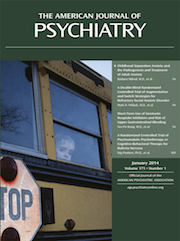Concerns About the Heritability of Serious Mental Illness: A Not-So-Strange Interlude

And then Sam's mother told me I couldn't have my baby. You see, Doctor, Sam's great-grandfather was insane, and Sam's grandmother died in an asylum, and Sam's father had lost his mind for years before he died, and an aunt who is still alive is crazy. So of course I had to agree it would be wrong—and I had an operation.
—Nina Leeds, Strange Interlude
Strange Interlude, penned 90 years ago by the great American playwright and Nobel laureate Eugene O’Neill, introduced the fear of “insanity” to modern American drama and won the Pulitzer Prize in 1928. The plot centers on Nina Leeds, who while pregnant learns that her husband Sam has a strong family history of “insanity.” Nina terminates the pregnancy and then conceives a child with another man, letting Sam believe that the child is his.
Dramatic representations of “insanity” and its heritability are common (the Pulitzer Prize–winning play Proof by David Auburn provides a more contemporary example). This both reflects and has the potential to affect community attitudes toward psychiatric illness. As in Strange Interlude, O’Neill’s plays often depict individuals who have no hope of controlling their destinies because of hereditary predispositions to behavioral and psychiatric traits. O’Neill himself seems to have had a personal and family history of psychiatric illness, including depression, alcoholism, substance abuse, and suicide (1).
Familial clustering of major psychiatric illnesses was observed by many of psychiatry’s founders and contributed to the historical concepts of degeneration and eugenics (2). Stigma about “bad blood” or a “curse” in the family was common, with the result that individuals were reluctant to disclose their family histories: “We are all only too well acquainted with the manner in which these people, even in the poorer ranks of life, endeavour by every means to keep from us a knowledge of such family taint,” stated Samuel Strahan, senior medical officer of Berrywood Asylum around 1890 (2). A frequent misunderstanding among both professionals and the public, which likely continues to this day, was that genetics and heredity meant determinism.
Recent data show the continued pervasiveness of concern regarding familial recurrence of schizophrenia and related psychotic disorders, but they also demonstrate that genetic counseling may be a therapeutic intervention capable of addressing this concern (3, 4). Concern about risk of recurrence may manifest as latent anxieties or overt psychological distress. Direct answers to questions regarding etiology and risk are often possible and frequently reassuring. Accurate knowledge of psychiatric genetics, including empiric recurrence risks and the role at this time for clinical genetic testing, will help clinicians incorporate features of genetic counseling into their practice for the benefit of patients and their families.
1 : The neurologic illness of Eugene O’Neill—a clinicopathological report. N Engl J Med 2000; 342:1126–1133Crossref, Medline, Google Scholar
2 : A History of Psychiatry: From the Era of the Asylum to the Age of Prozac. New York, John Wiley & Sons, 1997Google Scholar
3 : Evaluating genetic counseling for family members of individuals with schizophrenia in the molecular age. Schizophr Bull (Epub ahead of print, Oct 27, 2012)Google Scholar
4 : Evaluating genetic counseling for individuals with schizophrenia in the molecular age. Schizophr Bull (Epub ahead of print, Dec 12, 2012)Google Scholar



